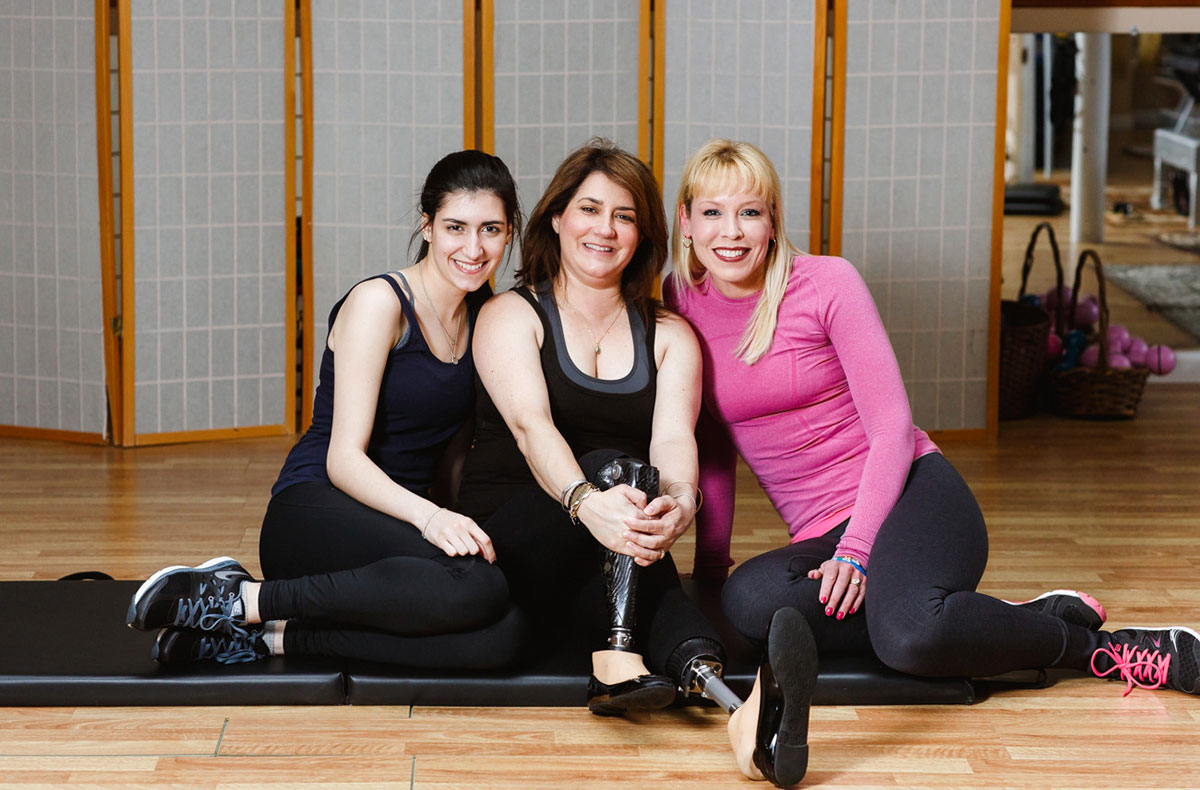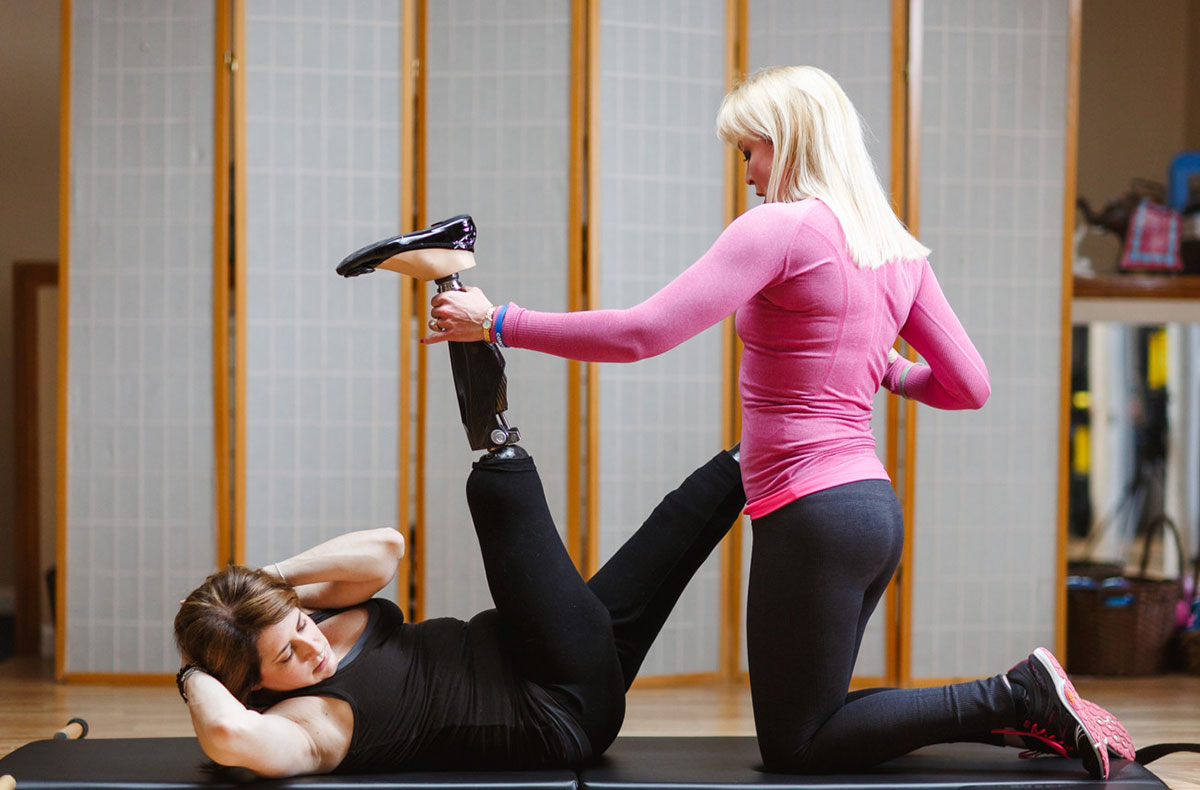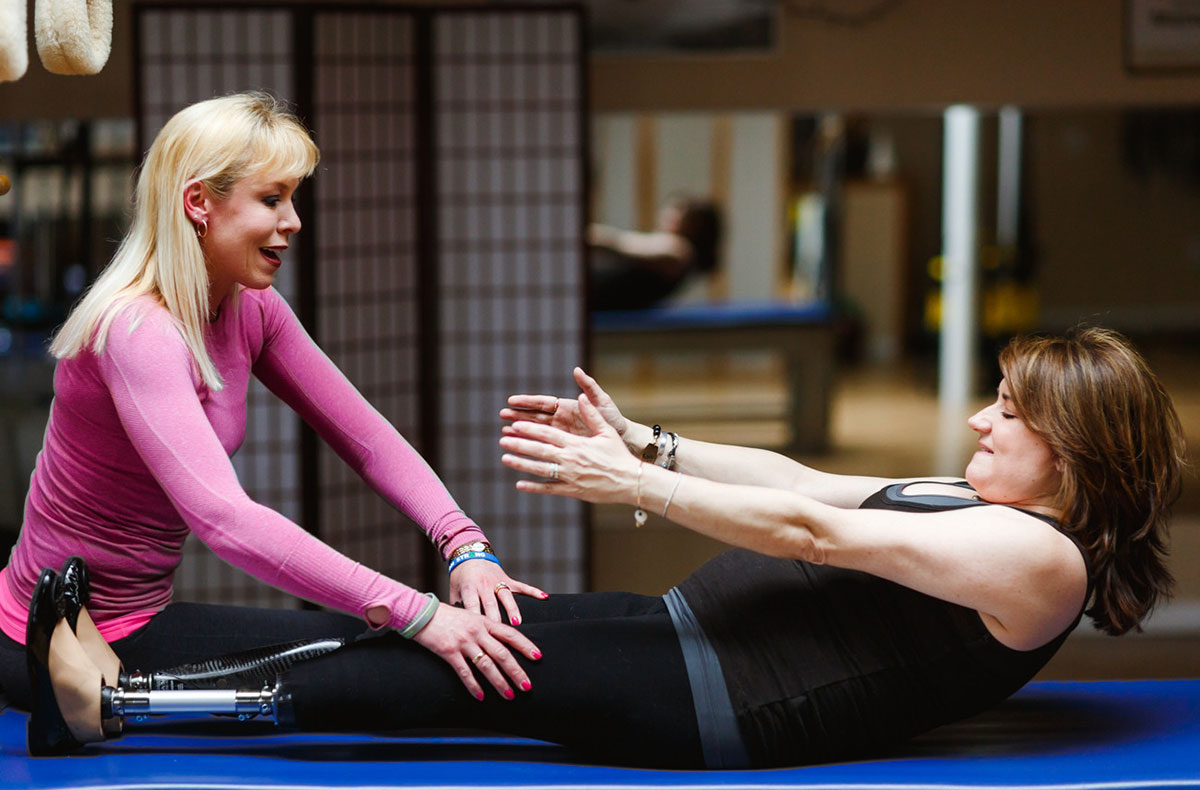Celeste Corcoran Is Using Pilates to Gain Back Her Strength

Sydney, Celeste, and Julie. All photos by Servidone Studios Photography.
Celeste Corcoran holds a perfect teaser, rolling back slowly, vertebra by vertebra, arms by her side, until her head hits the mat. She lets out a deep breath, and then, without any complaints, eases right into the next sequence in her Pilates routine.
On this rainy Friday evening in early April, Celeste is doing her usual Pilates private session. Except it’s not to lose weight or get in shape; it’s to help her live her everyday life. Her instructor, Julie Erickson, an Arlington-based personal trainer, Pilates instructor, and owner of Endurance Pilates and Yoga, has been leading these sessions three times a week pro bono, because she knows firsthand how difficult the first year as an amputee really is. “My mother was a double amputee due to Type 1 diabetes,” Erickson says. “I knew right away how Celeste’s life was going to change. I also knew that she would be okay, that she’d be able to learn to walk again, and that her prosthetic legs would eventually be just another part of her life, but it was going to take a lot of hard work to get there.”
Celeste and her daughter Sydney are survivors of the Boston Marathon bombings. In addition to having both legs amputated (one above the knee and one below), Celeste also had both ear drums blown out. Sydney, a freshman at Merrimack College in Andover, severed her femoral artery and nearly bled to death. While both women are healing, there’s still a lot of work to be done.
Celeste has landed on two sets of legs, which she received from the Prosthetic and Orthotic Association (POA) in Orlando, Florida, which “specializes in engineering and fitting high-performance, high-technology prostheses that support active lifestyles for patients,” and from 50 Legs, a charity that provides amputees with prosthetics and care, along with the Challenged Athlete Foundation. “I can not thank [50 Legs] enough,” Celeste says.
The new prosthetics are one thing, but it’s another ballgame to make them a part of her everyday life. For that, Celeste has received unsolicited support from many, many people.
In her first days at Boston Medical Center, Celeste met one of those people—“her Marine,” she’s quick to say—Gabriel Martinez, a veteran who lost both of his legs after stepping on an IED while on duty in Afghanistan. He walked in and said, “I’m just like you,” and showed her his prosthetics. “That gave me my first ray of life,” she says. “I stay in touch with him, I text him, and he helps me when I’m having tough times because my family is very supportive but nobody can understand quite what you are going through unless you have the same … you know, he’s a double amputee like myself.”
It’s Martinez’s support and the knowledge that she’s not alone that helps Celeste get through another grueling Pilates session. When training Celeste, Erickson digs right into the exercises. She is very hands on, and uses her expertise to support Celeste when she needs it, but also pushes her to work harder.
“This is absolutely what I need in order to be strong and walk comfortably and to have my balance,” Celeste says. “Because my legs were taken away, there are muscles that I hadn’t used before. I wasn’t in the greatest shape, but [Julie’s] been kicking my butt and getting me back in shape. And I noticed a difference almost immediately in my balance, like just standing. I believe that it’s absolutely because of Julie and the one-on-one attention that she gives me with the Pilates.”
“The beauty of Pilates is that it gives students control over their bodies,” Erickson says. “This is important for Celeste and Sydney as they take back control after their injuries, physically and mentally.”
Erickson says that she will continue to work with Celeste at her home, at the gym, on the treadmill running, and at her studio until Celeste “doesn’t need me anymore.” That may not be for some time. Sydney still has more surgeries in her future, and has recently joined her mom in her Pilates sessions. And while Celeste is gaining strength every day, making her new legs a part of her life will take time. Until then, she has Erickson.
“Julie is my Earth angel,” Celeste says. “I would not be walking as well as I do without [Pilates]. Julie saved my life.”
• • •
Erickson leads Celeste through a number of exercises during each of their Pilates sessions. Here are a few that stand out:
Working the Legs

Sidekick. Photo by Servidone Studios Photography
“We also work the glutes, hamstrings, adductors, and abductors in full ranges of motion while stabilizing the torso,” Erickson says. “Celeste has one above-the-knee amputation and one below-the-knee amputation. She has the inserts and origins of some very key muscles intact on her above the knee side which gives her a good degree of control over the actions of this hip. There is a difference in the flexibility and strengths of the hips on either side, and I really take that into consideration. When we are working out with her legs on, I am sure that we balance the amount of work done with each leg based on the differences in the prosthetic weights. One side is a lot heavier, so it would make no sense to do 10 leg lifts on each just to be even. But, the side with the heavier prosthetic is also the side that needs more muscle hypertrophy in the muscles that move the hip, so I also account for this difference in pure muscle strength to begin with.”
Criss-Cross

Photo by Servidone Studios Photography
“Criss-cross is usually done with one knee bending to stretch in and out. Because of the functionality in Celeste’s prosthetic knee, it cannot be done this traditional way, so we do an even more challenging version of this already difficult intermediate Pilates exercise,” Erickson says.
Roll Up

Photo by Servidone Studios Photography
“I have Celeste do roll downs/roll ups without any assistance, with my hands on her legs for support, with the support of a band or the roll down bar,” Erickson says. “We stop and hold, building endurance in the abs and core, back of legs for support, upper and middle back for stability.”
View more photos from Celeste’s intense Pilates session:

















